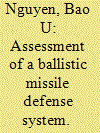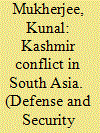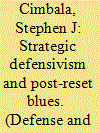|
|
|
Sort Order |
|
|
|
Items / Page
|
|
|
|
|
|
|
| Srl | Item |
| 1 |
ID:
128036


|
|
|
|
|
| Publication |
2014.
|
| Summary/Abstract |
This article presents a complete and self-contained analysis that assesses the effectiveness of a Ballistic Missile Defense System (BMDS). It does that by applying several techniques such as the properties of stochastic processes, the use of dynamical programing, the concept of generating functions and the applications of orbital mechanics. A step-by-step description starting from the computation of the number of engagement opportunities to the calculation of the probability of raid negation to the evaluation of the probability of integrated system effectiveness is introduced. The analysis also compares firing tactics in terms of effectiveness and inventory savings, assesses their contributions and limitations, as well as determines the driving parameters of a BMDS. New and optimal firing tactics based on more than one category of engagement opportunity are also described. The concept of redundancy and the possibility of boost-phase engagement are also explored in order to evaluate their impacts on the effectiveness of a BMDS.
|
|
|
|
|
|
|
|
|
|
|
|
|
|
|
|
| 2 |
ID:
128044


|
|
|
|
|
| Publication |
2014.
|
| Summary/Abstract |
Capability-based planning (CBP) is considered by many defence organisations to be the best practice for enterprise-level planning, analysis and management. This approach, loosely based around investment portfolio theory, is premised on balancing the cost, benefit and risk of capability options across the defence enterprise. However a number of authors have recently noted limitations of its current applications. The authors propose a more general, insurance-based approach, which can support the evolutionary improvement of the current CBP approach. This approach is implemented as hedging-based planning and aims to better reflect the enterprise nature of defence organisations, capturing both force structure and force generation aspects of military systems.
|
|
|
|
|
|
|
|
|
|
|
|
|
|
|
|
| 3 |
ID:
128042


|
|
|
|
|
| Publication |
2014.
|
| Summary/Abstract |
This study offers an investigation of the relationship between defense and social spending in the People's Republic of China. In particular, three consecutive questions are answered here. Does a warfare-welfare tradeoff exist in China's budgetary allocation? Is it positive or negative? What is the causal direction involved? By applying a vector autoregression analysis for the period of 1952-2006, this study finds a unidirectional crowd-out effect going from defense to social spending.
|
|
|
|
|
|
|
|
|
|
|
|
|
|
|
|
| 4 |
ID:
128040


|
|
|
|
|
| Publication |
2014.
|
| Summary/Abstract |
This article looks at the Kashmir conflict in South Asia, which has been going on since 1947, when India and Pakistan became independent from British colonial rule. After looking at some historical background, the article looks at both the external dimension as well as the internal dimension of the conflict. The external dimension tends to focus on Indo-Pak relations over Kashmir and the internal dimension looks at India's repressive state policies within the state of Kashmir. This article uses Mary Kaldor's "New War" thesis as a theoretical framework to understand the situation and pays special attention to the conflict's very complex and multifaceted nature. The article argues that although the levels of violence have differed from time to time in the region since 1947, today the conflict seems to have less to do with Indo-Pak relations or the external side of things and has more to do with the internal dimension and India's undemocratic ways within Kashmir. Today, Kashmir is one of the most militarised conflict zones in the world. The stationing of the Indian military and paramilitary forces in the region has only exacerbated the situation since it is the security personnel who cause much of the problem. The Armed Forces Special Powers Act gives these security forces extraordinary powers in the region, which they often abuse. The armed forces have no real understanding of the local culture or sympathy for local religious sentiments. Poverty, corruption, administrative failure, police brutality, identity politics and human rights abuses are some of the key features associated with this conflict. Methodologically, a number of interviews were carried out with the local people in the region recently. From the data gathered through the interviews, it is very obvious that the people still feel very oppressed and that the situation is still very volatile, fraught with uncertainty. Finally, after making an assessment of the situation, the article tries to suggest methods of peaceful building and conflict management as the way forward.
|
|
|
|
|
|
|
|
|
|
|
|
|
|
|
|
| 5 |
ID:
128039


|
|
|
|
|
| Publication |
2014.
|
| Summary/Abstract |
US nuclear deterrence and arms control policy may be moving, by design and by inadvertence, toward a posture of strategic "defensivism". Strategic "defensivism" emphasizes the overlapping and reinforcing impact of: (1) reductions in US, Russian and possibly other strategic nuclear forces, possibly down to the level of "minimum deterrence," (2) deployment of improved strategic and/or theater antimissile defenses for the US, NATO allies and other partners; and (3) additional reliance on conventional military forces for some missions hitherto preferentially assigned to nuclear weapons. This article deals with the first two of these aspects only: the interaction between missile defenses and offensive force reductions in US-Russian strategy and policy. The findings are that stable deterrence as between the USA and Russia is possible at lower than New Strategic Arms Reduction Treaty levels, but reductions below 1000 deployed long-range weapons for each state, toward a true minimum deterrent posture, will require multilateral as opposed to bilateral coordination of arms limitations. Missile defenses might provide some denial capability against light attacks by states with small arsenals, but they still fall short of meaningful damage limitation as between powers capable of massive nuclear strikes.
|
|
|
|
|
|
|
|
|
|
|
|
|
|
|
|
| 6 |
ID:
128038


|
|
|
|
|
| Publication |
2014.
|
| Summary/Abstract |
Although the Obama Administration has differed from its predecessor in a number of respects, on the specific issue of Ballistic Missile Defense (BMD), there is a striking continuity. The Obama Administration has remained committed to the BMD project, even as it has modified the schedule of deployments and prioritized different systems from the Bush Administration. Significantly, this has led to Chinese and Russian balancing in the nuclear sphere. As a result, there is evidence of a security dilemma-type dynamics in US relations with China and Russia. At present, there is no study that analyzes Russian and Chinese hard internal balancing against the USA in the sphere of missile defense during the Obama Administration. This article fills this gap.
|
|
|
|
|
|
|
|
|
|
|
|
|
|
|
|
| 7 |
ID:
128041


|
|
|
|
|
| Publication |
2014.
|
| Summary/Abstract |
Understanding contemporary conflicts in Africa remains directly dependent on the approaches employed to decipher or interpret them. This article first examines the bias of conventional approaches (inherited from the Cold War) and then those of a series of supposedly "newer" approaches. Relying primarily on West African examples, it offers a brief overview of current knowledge, issues, and avenues for research, based on three apparent characteristics of a "new generation" of conflicts: the regionalization of wars, the privatization of violence and security, and the recourse to extreme forms of brutality. These three major trends bear witness to a rapid transformation of war and armed violence over the past 20 years, but they are not sufficient to establish a radical historical break between "old" and "new" conflicts in Africa. By concealing elements of continuity a priori, the most influential "new" approaches actually make it impossible to ponder their own limits. To that end, fashionability and struggles for influence within the Africanist field play a major role in perpetuating dominant, sensationalistic, or simplistic (and invariably incorrect) portrayals of African conflicts.
|
|
|
|
|
|
|
|
|
|
|
|
|
|
|
|
|
|
|
|
|